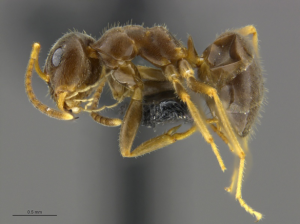The use of information is critical for an animal’s success. Animals must decide to explore new options or rely on their preexisting knowledge in multiple facets of their lives, including foraging for food. There are two important types of information that are distinguished in decision-making: the first are private information sources, where information cannot be accessed by others, such as memories; on the other hand, the realm of social information includes information gathered through interactions with other animals such as pheromone trails. Pheromones are secreted chemicals that can trigger a response in social members within a species. A drop of pheromone is deposited when the ant curves and dips part of its abdomen towards the ground surface.

Lasius niger (AntWiki)
Ants are an interesting insect to examine due to their social behavior, where the interest of the individual ants are aligned with the colony. This system makes social signals more valuable because there are lower chances of deception and the information providers are also benefiting from providing the social information but surprisingly, previous research examining information conflicts indicate that ants predominately follow their own memories and ignore social information. Furthermore, previous descriptive studies hint at a change in information use under different conditions, such as light.
Now switching gears to this study, the researchers specifically focused on wood ants, Lasius niger and looked at three different components in the relationship between light levels and information use by ants. The three questions that this study addressed were:
- Does Light Level Affect Pheromone Depositing?
- What is the Effect of Illumination on Information Use?
- Is Memory Based Solely upon Visual Cues?
Based on previous research, it was hypothesized that under high light levels, the ants will preferentially follow private route memories over pheromone trails. The experimental design for each research question and only location changed. The three light levels used in this study were: bright light (emulating a cloudy but bright day), moderate light (simulating dusk) and darkness (emulating a moonless night). A similar apparatus for the entire study consisting of a foraging trail in the shape of a T-maze was created with the left or right end containing a drop of 1 M sucrose.

Figure 1: Experimental Design of T-maze
Question 1: To test if light level affects pheromone depositing, the first experiment was in a windowless room to ensure that no visual cues were present and confounding factors were decreased. The depositing of pheromones was observed in all three light levels in a specific 5 cm location. Groups of 8-12 foraging ants were present on the maze at one time and in total, six colonies were used. As the level of light decreased from bright to moderate, it was shown that pheromone depositing increased significantly. However, when the light level was decreased again from moderate to dark, pheromone depositing did not continue enough to be statistically significant. A clear correlation of increase pheromone depositing with decreased light intensity was seen for all three visits to the sucrose.
Question 2: In order to test reliance on pheromone trails in decreasing light, the ants were presented with a conflict between their own route memory and a pheromone trail at a T-junction. A portion of the pre-existing pheromone trail was removed and placed opposite to the branch with the food source. The decisions of returning ants was recorded, totaling 10 colonies. Results indicated that more of the ant foragers followed the pheromone trails rather than their memory as the light intensity decreased. Ants who had not been to the sucrose location prior used the pheromone trail at the highest rate in the bright and moderate light levels.
Question 3: The aim of the third experiment was to investigate whether ants could develop a route memory in the absence of visual cues. This experiment was done in the lowest light level (darkness). Once ants had located the sucrose and returned to their nest, the paper in the T-maze was replaced to ensure that no pheromone was present and repeated. Ten colonies were used in this experiment. Results indicated that in darkness, ants that had made one visit to the food source did not perform better than naïve ants who had not visited the food.

Lasius niger worker ant (AntWiki)
So what do all of these results mean? The behavior seen is consistent with other ant species that utilize a “copy when uncertain” strategy in their decision making process. This is where the reliance on social information (such as pheromone trails) increases as the quality of private information (such as memory) is decreased. In this study, the results are understood as the ants’ efforts to increase information availability under challenging navigation conditions. Furthermore, this research helps strengthen the results of previous studies because the rate of pheromone following in naïve ants agrees well. How animals strategically use and deploy information has been intensely studied for many decades and this study further supports the use of the strategy of “copy when uncertain” compared to “copy if better” that can be found in other types of insects where one relies on social information when the outcome is may be better than the current situation.
When looking at the bigger picture, the greater field of sensory ecology, we must ask how this study fits in. It is actually just another piece of the never-ending puzzle. Studying visual information use under varying conditions such as light levels provides a powerful and ecologically relevant means of manipulating information richness. The use of information by ants under different light regimes also offers a promising means of studying information conflict and information use strategies. This study also has many implications for understanding the relationship between different sensory systems and information gathering and richness.
Reference: Jones, Sam, et al. “Copy When Uncertain: Lower Light Levels Increase Trail Pheromone Depositing and Reliance on Pheromone Trails in Ants.” Animal Behaviour, vol. 156, 2019, pp. 87–95., doi:10.1016/j.anbehav.2019.08.007.
